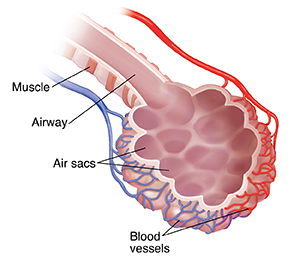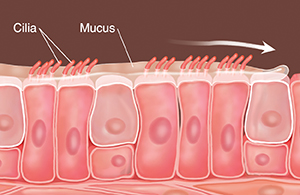How Your Lungs Work
The lungs’ job is to bring oxygen into the body. Your body needs oxygen to work. The lungs also rid the body of a waste gas called carbon dioxide. Inside the lungs, air moves through branching airways (tubes). These are made of stretchy tissue. Each airway is wrapped with bands of muscle. These help control the width of the tube. The airways branch out and get smaller as they go deeper into the lungs. The smallest airways end in clusters of tiny balloon-like air sacs (alveoli). These clusters are surrounded by blood vessels.

When you breathe
-
When you breathe in (inhale), air enters the lungs. It goes down through the airways until it reaches the air sacs.
-
When you breathe out (exhale), air goes up through the airways and out of the lungs.
The air you inhale contains oxygen. This is a gas your body needs. When this air reaches the air sacs, oxygen passes into the blood vessels. Oxygen-rich blood then leaves the lungs. It goes to all parts of the body. As the body uses oxygen, carbon dioxide is made. The blood carries this back to the lungs. Carbon dioxide leaves the body with the air you exhale.

To keep the lungs clean
The cells in the lining of the airways make a sticky substance called mucus. The mucus traps dust, smoke, and other particles in the air you breathe. The cells have tiny hairs called cilia. They sweep mucus up the airways to the throat. There it’s coughed out or exhaled.

To learn more
© 2000-2024 The StayWell Company, LLC. All rights reserved. This information is not intended as a substitute for professional medical care. Always follow your healthcare professional's instructions.